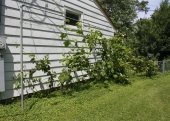Does anybody have them, and how do you set it up with permaculture?
I've been researching, and this is what I've found out.
There are two basic models for a permaculture vineyard that I've been able to find.
1. Rows of vines with grass growing in between the rows.
Advantages
a) Allows for a healthy micro environment in the grass same as on a good pasture or no till crop system.
b) Animals can be grazed on the grass strips. Chickens can be used threw out the year. Other animals can be used during the vines dormant period.
c) Can be cut down low before winter frosts to reduce chance of frost on grapes. All the experts seem to agree that low grass or bare ground is best for preventing frost damage to grapes on the vines. The grass can be grazed down low, or clipped with a mower with the clippings going under the vines as a mulch, or even harvested as hey/straw.
d) While technically a mono crop of grapes, the grass can be planted with many species of grass, clover, and nitrogen fixing legumes. This would reduce the risks of mono crop agriculture and benefit the land.
Disadvantages
a) Clipping the grass down low to prevent frost damage may inhibit micro habitat. Not an issue if you're in an area that does not get frosts until after October grape harvests.
2. Rows of vines with edible plants growing between the rows.
Advantages
a) You can grow food in otherwise unused space. Great if you have a limited space.
b) Would be less of a mono crop. Multi species of plants would reduce the chance of disease, pests, etc.
c) You could grow nitrogen fixing plants such as beans, peanuts, other legumes, or even dycon radish to help break up the soil for increased water permeability.
Disadvantages
a) You wouldn't be able to graze animals between the rows. You could run chicken wire, and graze chickens between the vines, and vegetables, but that would be a real pain in the arse.
b) Food garden wouldn't get much sunlight after grape vines start filling out and growing leaves.
Other considerations. The land you have to work with.
1. I was looking at a property yesterday that I wouldn't want to make an acre worth of vines in one spot. I would want to keep the oak bunches intact as areas to graze my heritage breed pigs, and the pastures open to graze cows. It has rocky graggy hilly areas here and there threw out the property on south facing grade. I would use those areas. Grapes seem to do well on rocky junk soil that is not good for other crops or pasture. Bad soil quality forces them to grow the roots deep into the soil. From what I've read, that's what make some of the best Pinot noir. There is no such thing as a good Pinot noir. It's either great or terrible. If you can grow a great Pinot noir, you can grow a great any wine variety. I would fence these areas off and after the grapes begin to ripen, I would cover them with bird netting. They would be small patches scattered all over the place. This would probably also decrease any problems associated with mono cropping.
2. Last week, I was looking at a couple properties that were pretty wide open pasture. So open, that I would have to plant oak trees for my pigs to get acorns. This would be too easy to just make an acre vineyard. Rectangular, square, triangle, whatever shape the land would allow figuring for contour, water run off, areas where I would want to create swales for orchards, ponds, etc. One of them has some steep rocky terrain, but it may be too steep, and the other looks like it gets a lot of rain runoff, and may be too soggy for part of the year. Both properties have been open range grazing land. No permaculture in sight. They both have visible signs of erosion. This can be repaired with some intensive grazing, and letting the land come back, then more intensive grazing, creating small damns with rocks in seasonal streams, swales, etc.
I never thought about starting a vineyard till recently. At first, I was only thinking about growing a few vines to make my own wine, and some table grapes to sell at the roadside stand. The more I researched, the more it seemed like a good idea. There is some good money in it, if you can do it well, and I think I would be a fool not to try. Especially since I'm planning on getting land in the Cali central valley Sierra foothills around or under 1200'. It comes down to diversification. Not having all your apples in one basket. Better to have many baskets, and oranges, and grapes, and pecans, and blueberries, and raspberries, and, and, and, etc too!!!
I searched this sight for permaculture vineyard. I didn't find much. If anyone has some links, suggestions, stuff to add to the above, etc, I would appreciate it.


